Muscle knots, post-workout soreness, and that nagging feeling of stiffness that limits your movement…we’ve all been there.
Whether you are training hard or coping with everyday stress, your body can feel tight and achy.
That’s where the foam roller comes in. Foam rolling may seem like a new fitness trend, but it’s actually very popular. Years ago, only pro athletes and therapists used these things.
There’s a reason for the popularity of this self-massage technique: it’s simple and works.
Nowadays, everyone from weekend warriors to office workers do foam rolling to relieve their aches and pains.
I personally enjoyed foam rolling. When I learned about its benefits, I realized it is the masterpiece of feeling better and moving more freely. RECOVERY also…
Ready to give it a try? In this blog, we’ll break down everything you need to know about foam rolling:
- What is foam rolling?
- How does foam rolling work
- Foam roller benefits
- Simple and effective foam roller exercises
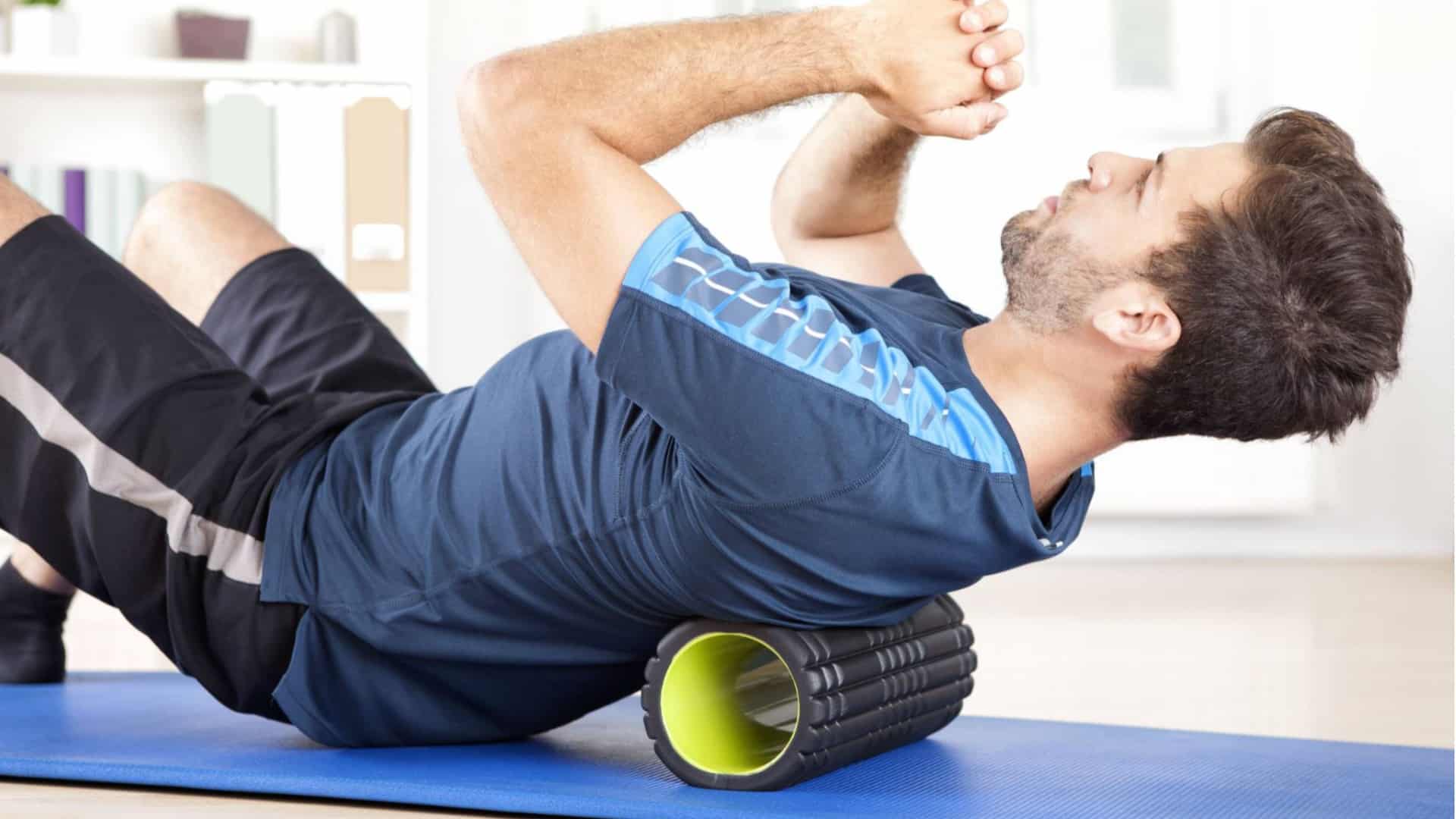
- What is a Foam Roller?
- Why Foam Rolling is Required
- How Does Foam Rolling Work
- Foam Roller Benefits
- 1). Ease Muscle Pain and Reduce Soreness
- 2). Improve Range of Motion and Mobility.
- 3). Improve Performance And Speed Up Recovery
- 4). It Restores Muscles and Prevents Injury
- 5). Help You to Relax
- 6). Reduce the Adhesion
- 7). Helps Improve Posture
- 8). Convenience
- 9). Increased Blood Flow
- 10). Relieve Back Pain
- 20 Best Foam Roller Exercises
- 1. Chest Foam Roll
- 2. Chest Opener Foam Roll
- 3. Side Shoulder Foam Roll
- 4. Front Shoulder Roll
- 5. Front Shoulder Hold and Stretch
- 6. Thoracic Spine Foam Roll
- 7. Foam Roller Thoracic Spine Extension
- 8. Lats Foam Roll
- 9. Roller Lats Hold and Stretch
- 10. Biceps Foam Roll
- 11. Triceps Foam Roll
- 12. Foam Roll Neck
- 13. Hamstring Foam Roll
- 14. Quadriceps Foam Roll
- 15. Adductors Foam Roll
- 16. Glute Foam Roll
- 17. Calf Foam Roll
- 18. Iliotibial Band (Outer Thigh) Roll
- 19. Shin Foam Roll
- 20. Core Foam Roller Exercise
- How To Use The Foam Roller
- 1. Choose a foam roller
- 2. Position yourself
- 3. Roll slowly
- 4. Pause on sore spots
- 5. Breathe
- 6. Move to the next muscle
- 7. Cool down
- Tips For Foam Rolling
- When To Use Foam Roller
- 1. Warm-Up Or Before Workout
- 2. Cool-Down Or After Workout
- 3. Post-Workout
- 4. Flexibility
- 5. Rehabilitation
- Importance Of Foam Rolling After Workout
- Types Of Foam Roll
- 1. Soft Foam Rollers
- 2. High-Density Foam Rollers
- 3. Grid Foam Rollers
- 4. Vibrating Foam Rollers
- 5. Deep Tissue Foam Rollers
- Takeaways
What is a Foam Roller?
Foam rolling is a self-massage technique that uses a foam roller to apply pressure to specific body areas. This practice can help release muscle tension, reduce inflammation, and improve flexibility and mobility.
Foam rolling is helpful for athletes or people who do regular physical activity because it can help them recover and prevent injuries.
But anyone can benefit from foam rolling, no matter how fit or active they are.
Foam rollers look super basic—they’re just cylinders of foam (or sometimes flexible plastic). But don’t let that fool you!
You can use this simple tool to give yourself a targeted deep-tissue massage by rolling different parts of your body over it
Try foam rolling your legs, including quads, glutes, and hamstrings—or even muscles in your back, hips, and shoulders.
Rolling over problem areas can help release that built-up tension in your fascia and re-establish muscle tissue integrity (and optimal performance).
Why Foam Rolling is Required
Foam rolling is a popular technique used to improve muscle health and mobility.
Foam rolling is also called myofascial release. But what is a fascia? And why do you want to “release” it? Fascia is the thin tissue that connects our muscles. Think of it as your body’s internal packaging—it helps muscle groups cooperate as integrated units.
When the fascia is healthy, it will be flexible and supple and will glide smoothly over your muscles.
However, unhealthy fascia can lead to the formation of adhesions, or knots, in the fascia, which can cause pain and stiffness. Adhesions can also limit blood flow to the affected areas.
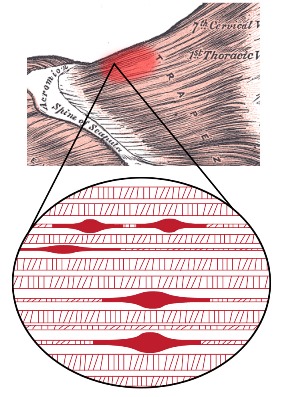
Adhesions in fascia may form due to various factors, such as muscle injury, inactivity, disease, inflammation, or trauma. Even sitting at a desk all day can cause fascia to become “gummed up” and stiff.
Foam rolling is a good way to remove adhesions in the fascia, improve flexibility, and increase blood flow to the muscle. This can increase flexibility and mobility, reduce pain, and improve physical performance.

How Does Foam Rolling Work
Think of foam rolling as a DIY massage.
The pressure you put on your muscles with the roller is surprisingly similar to what you’d get from a massage therapist. Type of self-induced massage.
Foam rolling works on a principle called myofascial release. The pressure of the foam roller helps increase blood flow to the area you’re rolling. This brings in oxygen and nutrients that speed up muscle recovery.
The pressure from foam rolling doesn’t just work on your muscles. It also sends signals to your nervous system, which can help ease tension and reduce pain signals.
This pressure helps boost blood flow, fix those little muscle kinks, and smooth movement overall.
According to a study, foam rolling has been shown to potentially benefit the recovery of dynamic measures (multijoint, sport-specific movements) during delayed-onset Muscle Soreness (DOMS).

Foam Roller Benefits
Foam rollers are a cost-effective and adaptable self-massage device that can provide numerous advantages to people of all fitness levels.
Below are some primary benefits of incorporating foam roller exercises into your routine:
1). Ease Muscle Pain and Reduce Soreness
A study published in the International Journal of Sports Physical Therapy found that foam rolling significantly reduced muscle soreness in participants.
This is thought to be due to increased blood flow and oxygenation to the muscles during foam rolling, which promotes faster recovery and reduces inflammation.
Foam rolling can also help to alleviate chronic muscle pain by breaking up knots or trigger points in the muscles.
Regular foam rolling can, therefore, be an effective way to manage and prevent muscle soreness and pain.
2). Improve Range of Motion and Mobility.
Poor mobility often results from the muscles and fascia becoming shortened, causing muscular trigger points, also known as knots.
Shortened muscles then obviously affect the range of movement and mobility, whilst trigger points can often cause pain and muscular fatigue.
Myofascial release can break up the developed scar tissue and trigger points, allowing these muscles to stretch further and develop back to normal, increasing their range of motion.
3). Improve Performance And Speed Up Recovery
The meta-analysis indicates that pre-rolling can enhance flexibility without affecting muscle performance. At the same time, post-rolling can improve performance and recovery rate for speed and strength measures.
Foam rolling breaks up the built-up scar tissue in the muscles and increases blood flow, providing the muscles with more nutrients and oxygen.
It also eliminates the overproduction of lactic acid. This boosts the recovery process.
4). It Restores Muscles and Prevents Injury
The published study found that foam rolling improved muscle activation and performance and prevented injuries.
Foam rolling will stretch and lengthen your muscles while breaking down scar tissue. As the scar tissue is broken down, your muscles can stretch further.
It will help restore the full range of motion, allow your muscles to load, and improve your performance during sports and exercise.
5). Help You to Relax
Many people find foam rolling relaxing. Breaking up tightness in their muscles may help them feel less tense and calmer.
Furthermore, slow, deep breathing while foam rolling and stretching reduces tension and pain, improving flexibility.
This suggests that practicing slow, deep breathing while foam rolling may help you relax and make foam rolling more effective.
6). Reduce the Adhesion
If you hold a muscle for long periods without moving it or use it a lot, you can make knots or adhesions that make it hard for the muscle sheaths to slide against each other.
The study found that foam rolling effectively decreased the presence of adhesions, leading to improved muscle function and range of motion.
The friction and pressure created by regular foam roller use can prevent collagen from binding between layers of muscle tissue.
7). Helps Improve Posture
Hunching over a computer at work, using a phone constantly, and prolonged sitting and driving contribute to tension in the upper back, neck, and shoulders.
This constant slumping can create stiffness, tightness over time, not to mention postural imbalances.
Using a foam roller may help relieve tension and improve flexibility, which in turn may correct imbalances and improve overall posture.
8). Convenience
Foam rolling has gained popularity not only for its physical benefits but also for its convenience, especially for those who don’t have access to a professional masseuse.
Unlike booking an appointment and paying a considerable amount of money, foam rollers are widely available and relatively inexpensive.
Moreover, foam rolling can be done practically anywhere, whether at the gym after a workout or at home.
9). Increased Blood Flow
Foam rolling is commonly used to alleviate muscle tightness, but recent studies suggest that it may also improve cardiovascular health by enhancing blood flow.
As you age, your arteries may become less flexible, which can lead to cardiovascular diseases and even mortality.
Tight muscles can impede blood flow to specific areas by using self-massage tools like foam rollers and performing stretching exercises.
10). Relieve Back Pain
Foam rolling may be a useful method for alleviating pain throughout the body, including tension in the back. However, to avoid further injury, be careful when using a foam roller on the back.
For lower back pain, it is recommended to position the foam roller vertically, in line with the spine, and gently roll it from side to side.
This technique is preferable to rolling horizontally, which can cause unnecessary strain and arching of the back.
Additionally, you may find relief by lying on a foam massage ball or tennis ball to target specific knots or areas of tens
20 Best Foam Roller Exercises
1. Chest Foam Roll
Foam rolling the chest involves using a foam roller to massage the muscles in the chest area. It reduces muscle soreness and tightness throughout the chest.
I used to think foam rolling was mostly for legs and back, but then I tried it on my chest – It is AWESOME.
Benefits Of Foam Rolling Chest
- It helps to improve posture by loosening tight chest muscles that can contribute to rounded shoulders and forward head posture.
- It can increase the range of motion and mobility in the shoulders and upper back.
- It may reduce pain and tension in the chest muscles.
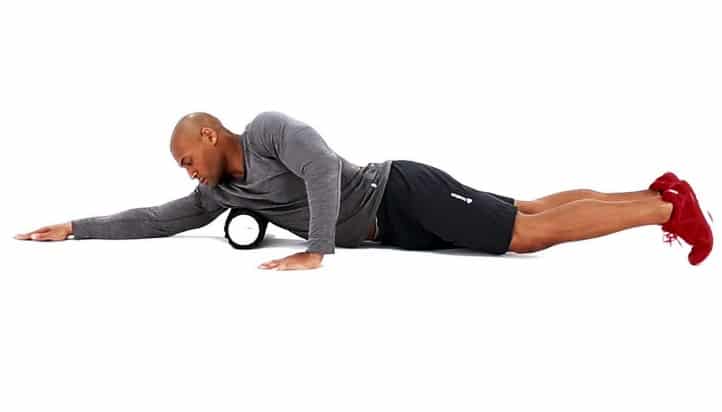
How To Do
- Lie face down on the floor with the foam roller under your chest.
- Position the roller at the top of your chest and slowly roll down towards your rib cage.
- Pause and hold for a few seconds on any areas that feel particularly tight or tender.
- Slowly roll back up to the top of your chest and repeat for several repetitions.
Tips
- Try using a slower rolling speed to allow the muscles to release tension.
- Avoid rolling directly over the sternum bone, as it can be painful.
- If you find a particularly tender spot, hold the roller on that spot and take a few deep breaths to allow the muscle to release.
2. Chest Opener Foam Roll
The chest opener foam roll is an exercise that uses a foam roller to stretch and open up the chest muscles, which can become tight and restrictive due to poor posture or too much sitting.
Chest openers improve posture by preventing rounded shoulders and hunching that comes with long hours of sitting or computer work.
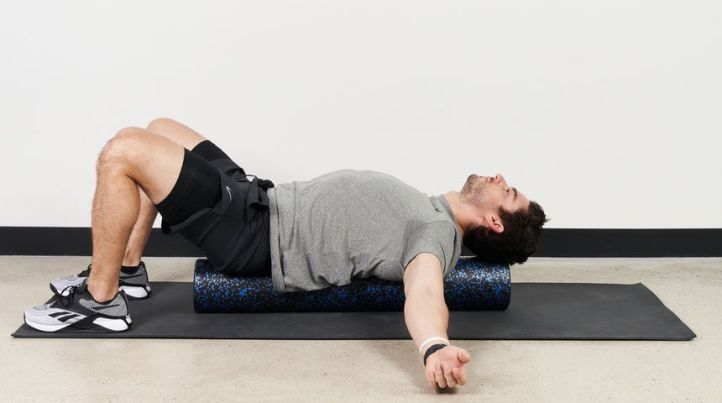
Benefits Of Chest Opener Foam Roll
- It helps to reduce shoulder pain and tightness by opening up the chest muscles and reducing shoulder tension.
- Increases shoulder mobility and flexibility by stretching the anterior deltoids, pec major, and pec minor muscles.
How to Do
- Place the foam roller horizontally on the ground and sit in front of it with your knees bent and feet flat on the ground.
- Lie back on the foam roller so that it is positioned across your upper back and shoulder blades.
- Spread your arms wide and out to the sides, with your palms facing upward.
- Take deep breaths and relax into the stretch, holding for 30–60 seconds before rolling off the foam roller.
Tips
- Be sure to keep your head and neck supported throughout the stretch.
- If the stretch is too intense, try using a smaller foam roller.
- Focus on breathing deeply and relaxing into the stretch.
3. Side Shoulder Foam Roll
The side shoulder (lateral deltoid) foam roll is a form of self-myofascial release that targets the muscles on the side of your shoulder.
I couldn’t believe my shoulders were tight until I tried foam rolling. It was a bit intense, but wow, did it feel good. Now, my shoulders are less stiff and less painful, and I can move them way better.
Benefits Of Foam Rolling Side Delt
- Relieves tension and tightness in the side shoulder muscles
- Reduces pain and soreness in the shoulders
- Improves shoulder mobility and range of motion
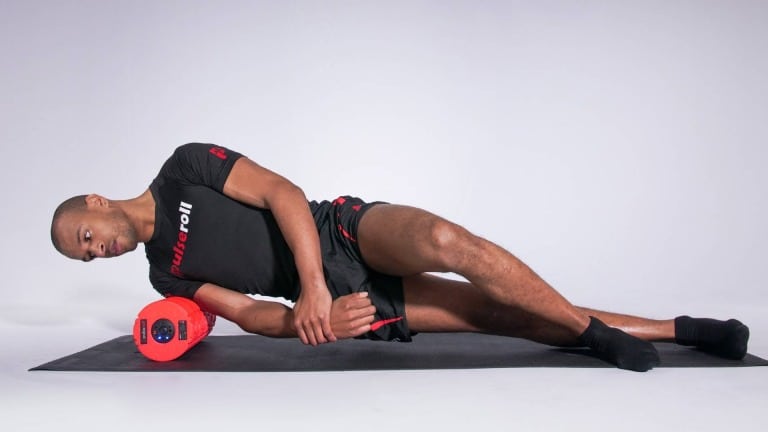
How To Do
- Lay on your side with both knees bent. Place the roller under the shoulder.
- Place your other hand on the ground in front of you to support
- Slowly roll the foam roller up and down the side of your shoulder, focusing on any tight or sore spots
- If you find a particularly tender area, hold the foam roller in place for 20–30 seconds to allow for deeper pressure
- Repeat on the other side
Tips
- Start with a softer foam roller if you are new to foam rolling or have particularly sensitive shoulders
- Avoid rolling directly on your shoulder joint
- Control the amount of pressure you apply to the foam roller
- Breathe deeply and relax into the stretch to maximize its benefits
4. Front Shoulder Roll
The front shoulder roll, also known as the anterior deltoid roll, targets the front side of shoulder muscles and helps to release tension and improve mobility in the shoulder joint.
According to a published study, foam rolling has been found to enhance shoulder flexibility and alleviate muscle soreness.
Benefits Of Foam Rolling Front Shoulder
- Reducing muscle tension and soreness in the front delt and chest.
- Improving posture by releasing tight muscles that may be causing rounded shoulders
- Enhancing performance in exercises that involve shoulder movements, such as bench press, overhead press, and push-ups
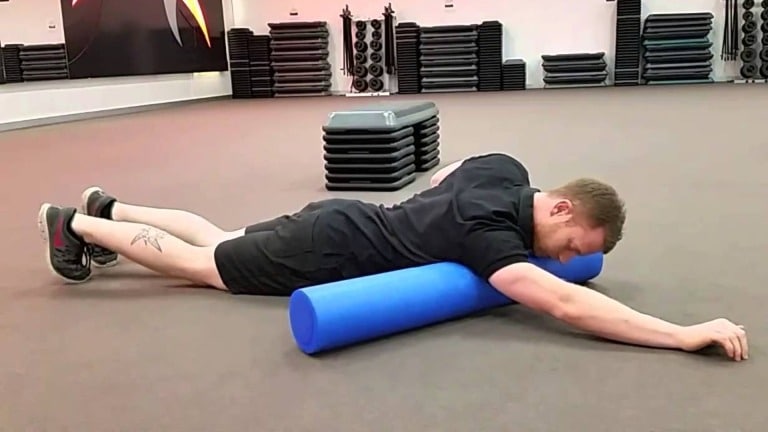
How To Do
- Place the foam roller under the upper chest where it meets the shoulder while using the other arm for support.
- Find a comfortable position for your lower body, and push the roller a few centimeters forward and backward with your upper body.
- Stop and hold on to any tight spots for 20–30 seconds.
- Repeat on the other side.
Tips
- Start with a softer foam roller if you’re new to foam rolling or have sensitive shoulders.
- Avoid rolling directly over the bone and focus on the muscle tissue.
5. Front Shoulder Hold and Stretch
Front shoulder hold and stretch require applying pressure with a foam roller while holding a stretch in the front shoulder muscles.
Benefits Of Front Shoulder Hold and Stretch
- Improve shoulder mobility,
- Reduce muscle tightness and soreness
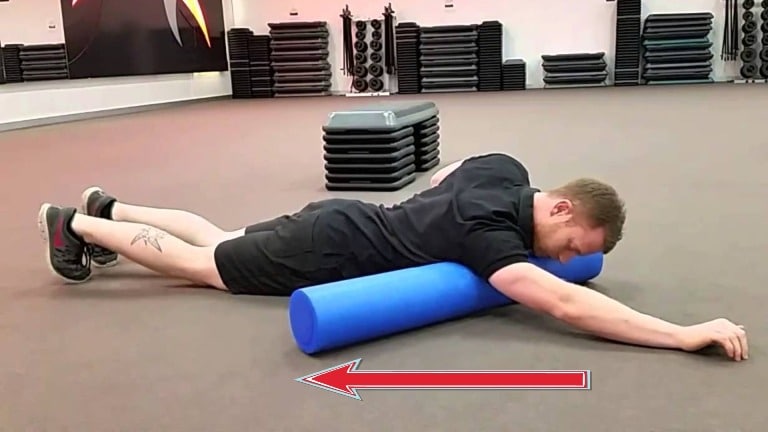
How To Do
- Place the foam roller under the upper chest where it meets the shoulder while using the other arm for support.
- Keeping the roller fixed, pulling the arm in a downward motion.
- Push the arm forwards as you were going to straighten it.
- When you find a tender spot, hold the stretch for 10–30 seconds while taking deep breaths.
- Release and move on to the next tender spot.
Tips
- It is important to keep the roller stable.
- Gradually increase the intensity and duration of the exercise over time.
Know More: Best Foam Roller Exercises For Shoulders
6. Thoracic Spine Foam Roll
Our upper back is exposed to much stress from daily activities such as exercising, sitting, and bending over. Since we cannot avoid doing these activities, loosening this area whenever it feels tight is important.
Foam rollers are an effective way to loosen up the thoracic spine and alleviate pain. They targets the middle and upper back muscles, including rhomboids, traps.
I’ll be honest: the first time I tried this, it felt a little awkward and uneasy. But once I got the hang of it, it quickly became one of my favorite rolls.
Benefits Of Foam Rolling Thoracic Spine
- Reduces upper back pain and stiffness
- Increases mobility and flexibility in the thoracic spine
- Enhances breathing and lung capacity
- Reduces tension in the shoulders and neck
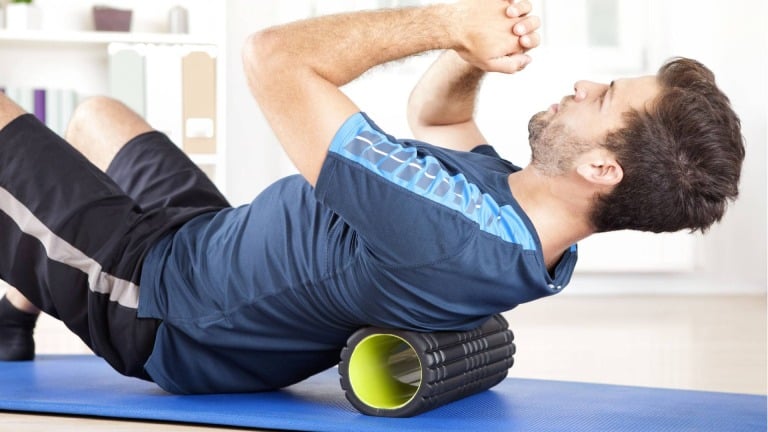
How To Do
- Lay on your back with your knees bent, placing your hands behind the back of your head or in front of you, with the foam roller just below your shoulder blades.
- Lift your hips off the floor and slowly push through your heels to move back and forth from your mid-back to the top of your shoulder blades.
- Keep your spine and head aligned in a neutral position.
- When you find a sore spot, stop and hold the position for at least 10–30 seconds until you can feel the muscle relax.
Tips
- Avoid rolling directly on your spine or lower back.
- Keep your abs engaged to support your lower back and avoid overarching.
- Breathe deeply and slowly to help relax your muscles and release tension.
7. Foam Roller Thoracic Spine Extension
Maintaining mobility in the thoracic spine is crucial to avoid shoulder, neck, and lower back pain. If the T-spine cannot move freely, adjacent joints must overcompensate, leading to instability and soft tissue damage.
This compensation can also cause misalignment and nerve pressure in the lumbar vertebrae, resulting in severe pain.
Benefits Of Roller Thoracic Spine Extension
- Help alleviate upper back pain,
- Reduce tightness in the thoracic spine,
- Improve posture and enhance athletic performance.
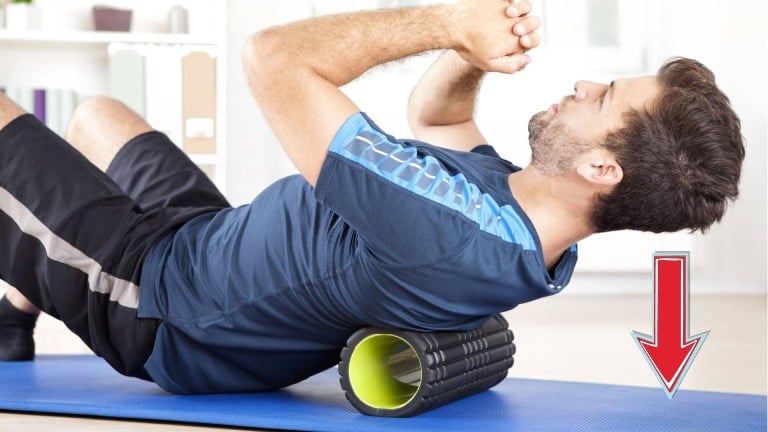
How To Do
- Lay on your back with your knees bent, placing your hands behind the back of your head, with the foam roller just below your shoulder blades.
- Keep your hips on the floor and your feet hip-width apart.
- Slowly begin to bend backward over the roller.
- Stopping at a point where it feels comfortable.
- Return to the starting position and repeat.
Tips
- Keep your neck relaxed
- Avoid using your lower back to push yourself up.
- Breathe deeply and slowly while doing the exercise.
8. Lats Foam Roll
This foam roll exercise targets your lats (latissimus dorsi), the big muscles on the sides of your back that control everything from posture to overhead movements.
The first time I rolled my lats, it was intense. But afterward, my shoulders felt less tight, I gained flexibility, and it was a great full-body stretch.
Benefits Of Foam Rolling Lats
- It benefits weightlifters and athletes, as it can help relieve sore muscles and prevent injury.
- Reduces muscle tension and soreness in the lats
- Improves flexibility and range of motion in the shoulders and upper back
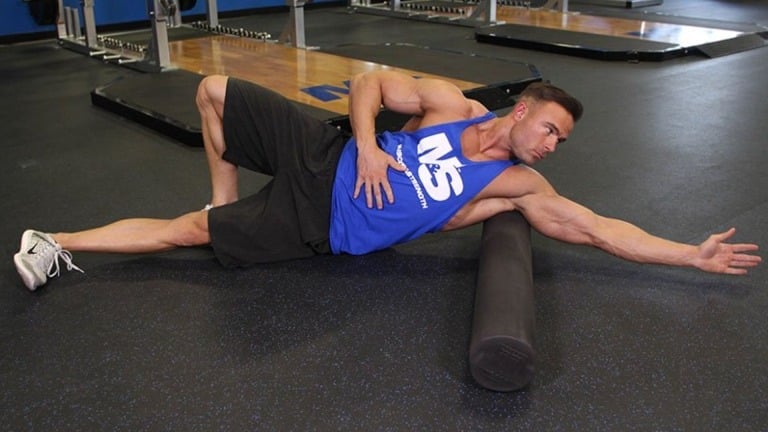
How To Do
- Lay on your side and extend the bottom leg. Bend your top knee and keep your foot firmly pressed to the floor.
- Place the roller under the armpit and extend the bottom arm.
- Length the arm with the palm facing upwards.
- Then, use your legs to slowly shift your body 10–15 cm upwards and downwards.
- Repeat on the other side
Tips
- Be careful not to roll too close to the shoulder joint, which can cause discomfort or injury.
- Use your free hand to support your body weight and control the pressure applied by the foam roller.
- Pause for 5–6 seconds on tender spots and take slow, deep breaths to relax.
9. Roller Lats Hold and Stretch
Foam roller Lat hold and stretch focuses on stretching and releasing tension in the latissimus dorsi muscles, commonly known as the lats.
Research studies published by the National Institute of Health indicate that foam roller use can enhance range of motion and reduce pain after intense exercise, and also relieve symptoms of fibromyalgia.
Benefits Of Roller Lats Hold and Stretch
- Increase the flexibility of the lats muscles, making it easier to do daily activities and exercises.
- Improve posture and reduce the risk of shoulder and back pain.

How To Do
- Lay on your side with the legs in a bent position that feels comfortable.
- Place the foam roller perpendicular to your body, under the middle to the upper part of your side back.
- The length of the arm with the palm facing upwards.
- Slowly pull the arm down towards your chest, bending at the elbow. Lengthen the arm and repeat.
Tips
- Use a foam roller that is firm enough to provide adequate pressure but not so hard that it causes pain.
- Breathe deeply and relax your muscles during the stretch.
- Don’t roll over your rib cage or spine, which can cause injury.
Know More: Best Foam Roller Exercises For Back
10. Biceps Foam Roll
Biceps Foam Roll is a self-myofascial release (SMR) exercise that targets the biceps muscle. It involves using a foam roller to pressure the biceps muscle to release tension and knots.
Foam rolling your biceps after training will help flush away lactic acid, provide faster recovery, and reduce soreness the next day.
Benefits Of Foam Rolling Bicep
- Relieves muscle soreness and stiffness in the biceps muscle.
- Improves biceps muscle flexibility and range of motion.
- It can help treat conditions such as tendonitis, bicep strains, and frozen shoulder.
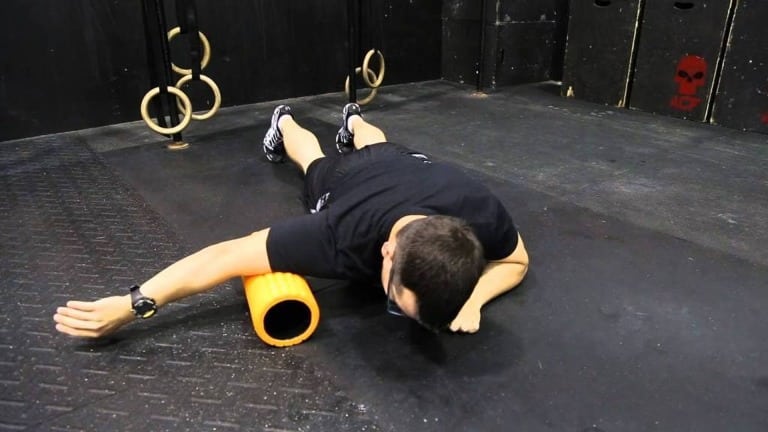
How To Do
- While lying on your stomach, reach one arm to the side and place the roller under your elbow.
- Keep the palm facing down.
- Using the other arm as support, push the arm to move the roller towards the shoulder.
- Pull through the arm to return to the start. Repeat on the other side.
Tips
- Don’t roll too fast. Slow and controlled movements are more effective.
- Apply enough pressure to feel a deep massage, but not so much that it’s painful.
- Avoid rolling directly over the elbow joint.
11. Triceps Foam Roll
Tricep foam rolling is a technique of self-myofascial release that focuses on the triceps brachii muscle, located on the back of the upper arm.
Foam rolling the triceps helps to relax tight muscles and improve blood flow, making it an essential part of your warm-up routine to ensure proper muscle engagement during a workout.
It is equally important as a cool-down exercise after a workout to aid in recovery and prevent strain or injury.
Benefits Of Foam Rolling Tricep
- Reduces tricep muscle soreness and fatigue after a workout.
- It helps to break up scar tissue and adhesions in the muscle.
- It relieves tension in the triceps muscle, which can help alleviate elbow and shoulder pain.
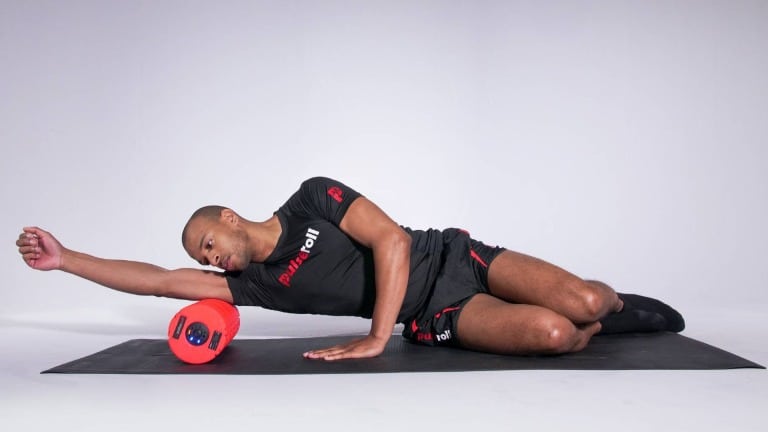
How To Do
- Lie on your side with the foam roller placed underneath your triceps muscle.
- Keep your opposite hand on the floor to help support your body weight.
- Slowly roll up and down the length of your triceps muscle, stopping at any tender spots.
- When you find a tender spot, pause for a few seconds and take a few deep breaths while relaxing the muscles.
- Continue rolling on each arm for 1–2 minutes.
- Repeat on the other side.
Tips
- Start with a low-density foam roller and gradually work your way up to a firmer one as your muscles adapt.
- Avoid rolling over your elbow joint or any bony protrusions.
- Do not roll over any areas of acute pain or inflammation.
- Do not put all your weight on the foam roller. Use your opposite hand to control the pressure.
12. Foam Roll Neck
Neck pain is a common issue in adults, caused by various factors such as poor posture, overuse, and sleeping wrong. Studies suggest that 14-71% of adults experience neck pain at some point in their lives.
It can lead to discomfort and inconvenience and even cause back, shoulder, and arm pain and headaches.
Using a foam roller can be a simple solution to relieve neck pain and prevent chronic pain.
Benefits Of Foam Rolling Neck
- Reducing neck pain and stiffness
- Improving range of motion in the neck
- Promoting better posture
- Reducing headaches
- Reducing stress and tension
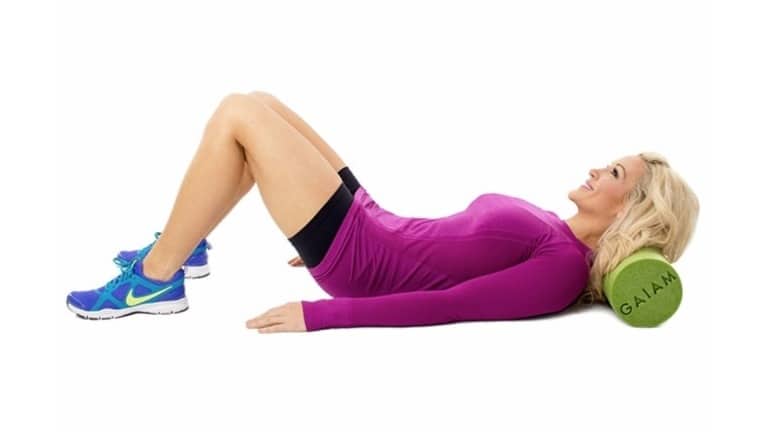
How To Do
- Lay on your back on a yoga mat or soft workout surface, with a foam roller placed lengthwise under your neck.
- Keep your feet flat on the ground and your knees pointing upwards.
- Slowly turn your head to the right, holding where you feel a tightness.
- Exhale and turn your head to the left. Repeat for 10–30 seconds.
- Repeat the side-to-side rotation to relieve neck tension.
Tips
- Be gentle and start with less pressure
- Do not roll back and forth; only rotate side to side.
13. Hamstring Foam Roll
Hamstring rolling is a foam roller exercise that targets the hamstrings, which are the muscles located at the back of your thighs.
During the exercise, you place the foam roller underneath your hamstrings and roll back and forth to apply pressure and massage the muscles.
Foam rolling my hamstrings made me way less stiff. I can bend easier and my legs just feel looser overall
Benefits Of Foam Rolling Hamstring
- Foam rolling the hamstrings can aid post-workout recovery, potentially reducing soreness after squats and deadlifts.
- Also, it can improve hamstring flexibility, which leads to better posture and knee strength.

How To Do
- Sit on the floor and place a foam roller underneath your legs, just above your knees.
- Relax your feet and legs. Use your hands to lift yourself up and roll back and forth from above the knees and to the beginning of your glutes.
- Keep your torso straight and your spine in a neutral position.
- When you find a sore spot, stop and hold the position for at least 30 seconds until you can feel the muscle relax.
14. Quadriceps Foam Roll
The quadriceps, consisting of four muscles, run down the front of the thigh and form the patella tendon, working together to extend the knee.
Sitting for extended periods can cause the quadriceps and hip flexors to feel tight and overextended.
Foam rolling my quads has become a non-negotiable part of my leg day routine. It makes me feel good and makes my legs feel better the next day.
Benefits Of Foam Rolling Quads
- Quadriceps rolling can help improve quadriceps flexibility and range of motion, improving overall mobility and performance.
- Tight quads can reduce mobility and performance by limiting knee flexion. Quadriceps rolling can improve knee flexion, which is beneficial for athletes.

How To Do
- Lie on your front and place a foam roller underneath your thighs, just above the knee.
- Rest your upper body on your elbows.
- Using your arms, gently push yourself back and forth to roll from above the knee and to the top of the thigh.
- Keep your spine and head aligned in a neutral position.
- When you find a sore spot, stop and hold the position for at least 30 seconds until you can feel the muscle relax.
15. Adductors Foam Roll
Adductor roll is a foam roller exercise that targets the adductor muscles on the thigh’s inner side.
Foam rolling your adductors (inner side of the thigh) is an effective warm-up and cool-down method for lower body workouts that require mobile adductors.
Benefits Of Foam Rolling Adductors
- Tight adductors pull the hips forward, causing poor posture. Adductor rolling can improve posture by reducing tightness in the muscles.
- Better flexibility and mobility of the adductors can also help prevent groin strains.
- Adductor rolling can help increase the range of motion in the hips.

How To Do
- Lay face down, extend one leg and bend the other at the knee.
- Place the Roller vertically under the thigh of the bent leg and rise onto the elbows.
- Use the arms to push across, moving the Roller towards the hip. Pull through the arms to return to the start.
- Repeat on the other side.
16. Glute Foam Roll
Glute foam rolling is a form of self-myofascial release that targets the gluteal muscles located in the buttocks.
According to the study, glute foam rolling can promote muscle relaxation, enhance hip range of motion and flexibility, and improve posture.
After sitting for long hours, it makes my glutes feel tight.
And foam rolling has become my go-to way to loosen them up and feel better.
Benefits Of Foam Rolling Glute
- Glute foam rolling can help enhance range of motion and flexibility, improving overall athletic performance.
- Improve muscle activation in the gluteals, which are important for daily activities like stair climbing and sports movements like running.

How To Do
- Sit on top of the foam roller and cross one ankle over the opposite knee. Use your hand to steady yourself.
- Relax your leg and tilt toward the bent leg. Slowly roll from the top to the bottom of the glute muscle.
- When you find a sore spot, stop and hold the position for at least 30 seconds until you can feel the muscle relax.
- You can also roll back and forth over the glute for 30–60 seconds.
- Switch sides and repeat the process.
17. Calf Foam Roll
Foam rolling the calves can improve ankle mobility. It helps to reduce fascial restrictions in the lower leg, leading to better movement and improved sports performance.
It helps reduce tightness and soreness in the calves, increase flexibility and range of motion, and improve blood flow.
Benefits Of Foam Rolling Calf
- Reduces muscle tightness, soreness, and pain in the calf muscles.
- It helps to increase the range of motion and flexibility in the calf muscles.
- It can improve muscle activation and performance during activities such as running, jumping, and walking.
- Improves ankle dorsiflexion and overall ankle mobility.

How To Do
- Sit on the floor and place a foam roller underneath your legs, just above your ankles.
- Relax your feet and legs. Use your hands to lift yourself up and roll back and forth from above the ankle to below the knee.
- When you find a sore spot, stop and hold the position for at least 10–30 seconds until you can feel the muscle relax.
- Switch sides and repeat the process.
18. Iliotibial Band (Outer Thigh) Roll
The IT band is a thick fibrous tissue that runs down the outside of your leg and attaches to the side of your knee.
IT band rolling involves using a foam roller or other tool to pressure the IT band to release tension and improve mobility.
Benefits Of Foam Rolling IT Band
- It band rolling can help alleviate pain and tightness in the IT band, which is a common issue for runners and other athletes.
- Improved IT band mobility can improve overall lower body mobility and sports performance.

How To Do
- Lie on your side and place a foam roller underneath your leg, just below your hip.
- Cross the opposite leg in front and steady yourself with your arm bent at 90 degrees.
- Relax your leg. Using your other arm, push to slowly roll back and forth from just below your hip to just above your knee.
- When you find a sore spot, stop and hold the position for at least 30 seconds until you can feel the muscle relax. Switch sides.
19. Shin Foam Roll
The shin foam roll targets the anterior tibialis, which is crucial for ankle mobility and proper squatting and deadlifting technique.
Limited dorsiflexion can cause your heels to lift during squats and limit your range of motion.
Foam Rolling the anterior tibialis can improve ankle mobility, allowing for deeper squats and smoother running.
Benefits Of Foam Rolling Shin
- Shin foam rolling can help reduce pain caused by shin splints, which is a common overuse injury in athletes and runners.
- It also helps relieve tightness and improve range of motion in the ankle joint.

How To Do
- Place the roller under one shin (just above the ankle) on all fours.
- Use your hands to lift your hips off the ground and roll the foam roller up and down your shins.
- If you find a tight or sore spot, hold the foam roller in place for a few seconds and then continue rolling.
- Roll for 1–2 minutes per leg, and repeat as needed.
Tips
- Start with a softer foam roller to avoid excess discomfort if you’re new to foam rolling.
- Avoid rolling over bony areas such as the front of your ankle.
- Don’t roll too quickly; instead, go slowly and steadily.
20. Core Foam Roller Exercise
Using a foam roller for core exercises can help strengthen your core, which supports posture, stability, and alignment.
Try this exercise to strengthen your core and improve posture, stability, and alignment.
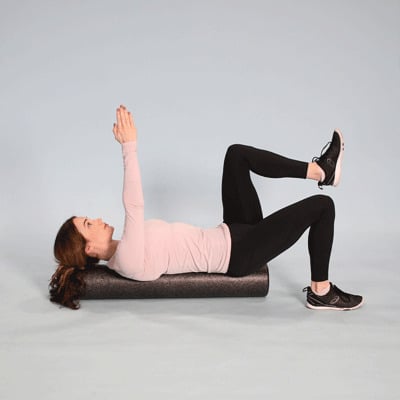
Benefits
- Strengthens your core muscles
- Improves your posture and alignment
- Enhances your stability and balance
- Releases tension and tightness in your core muscles
How To Do
- Lie on your back with a foam roller along your spine, supporting your head and tailbone.
- Bend your knees and place your feet on the mat, with your arms resting alongside your body.
- Engage your core muscles and press your lower back into the foam roller.
- Lift your right hand and left knee towards the ceiling.
- Return to the starting position and repeat on the opposite side.
- Complete 8 to 16 repetitions on each side for 1 to 3 sets.
Tips
- Keep your neck and shoulders relaxed throughout the exercise.
- Don’t hold your breath or rush through the exercise.
- Maintain a steady pace and focus on proper form.
How To Use The Foam Roller
Foam and tube rolling training works by applying localized pressure to chosen areas of the body using prescribed techniques.
When pressure is applied with a roller, it helps increase the circulatory flow through that area, reducing soft tissue damage and improving movement.
Here are some steps to help you get started with foam rolling:
1. Choose a foam roller
Foam rollers come in different densities, so choose one that suits your experience level and the specific muscles you want to target.
2. Position yourself
Sit on the floor with the foam roller positioned under the muscle you want to work on. Use your hands to support your weight behind you.
3. Roll slowly
Start by rolling the foam roller back and forth along the length of the muscle. Apply moderate pressure. Move slowly and steadily, focusing on areas of tension or soreness.
The motions place both direct and sweeping pressure on the soft tissue, stretching it and generating friction between it and the foam roller.
4. Pause on sore spots
It is very possible to find several trigger points throughout your body. When you hit a spot that’s especially painful or tight, pause here and try to relax.
Pause and apply gentle pressure for 10 to 20 seconds when you find a sore spot. This can help release knots and relieve muscle tension.
5. Breathe
Remember to breathe deeply and slowly throughout the foam rolling session. This can help you relax and release tension.
6. Move to the next muscle
Once you have completed one muscle group, move on to the next muscle and repeat the process.
7. Cool down
After foam rolling, stretching and cooling down is important to prevent muscle soreness.
Tips For Foam Rolling
- Try to identify your trigger point and maintain constant pressure over the area for at least 10–30 seconds while slowly breathing. Any discomfort or tenderness will gradually ease.
- Try to relax while foam rolling. This will reduce the possibility of cramps.
- Never roll on a joint.
- Slowly and specifically roll each targeted muscle for 1–2 minutes.
- If an area is too painful to apply direct pressure, shift the roller and apply pressure on the surrounding area to loosen the entire area gradually
- After foam rolling, perform some gentle static stretches to promote further flexibility.
- Rolling out can do more harm than good when it is done over the wrong areas, such as the lower back, and directly over a joint or bone.
- If an area is too painful to apply direct pressure, shift the roller and apply pressure to the surrounding area to loosen the entire area gradually.
The exercises have been designed to help you enhance and optimize performance. Giving you a functional body that feels stronger with a reduced risk of injury and pain.
Let’s get started and make your body move and feel better.
When To Use Foam Roller
Foam rollers can be used in many ways to benefit your muscles:
1. Warm-Up Or Before Workout
Foam rolling can help bring blood flow to inactive muscles, reduce stiffness, and mentally prepare you for your workout ahead.
Rolling before exercise improves tissue elasticity, range of motion, and circulation. This could improve mobility during your workout and protect you from injury.
2. Cool-Down Or After Workout
While foam rolling after training prevents muscle soreness, it also helps reduce it by bringing healing blood flow to the working muscles and lowering your heart rate.
3. Post-Workout
Foam rolling is an effective tool for post-workout recovery, so foam rolling the day after a heavy workout helps reduce soreness and speed up recovery.
Foam rolling helps prevent the formation of myofascial adhesions while building new muscle.
4. Flexibility
Foam rollers can improve flexibility by targeting tight muscles and fascia. By rolling out the hamstrings, quads, and calves, you can improve your range of motion.
5. Rehabilitation
Foam rollers can be used for rehabilitation purposes to aid in the recovery of injured muscles. They can help to break up scar tissue, reduce muscle stiffness, and increase range of motion.
Importance Of Foam Rolling After Workout
Exercise can often induce various degrees of musculoskeletal, nervous, and metabolic fatigue. Depending on the frequency, intensity, duration, and type of exercise performed, it can also cause discomfort, pain, and inflammation.
After intense exercise, this discomfort and pain commonly are associated with delayed-onset muscle soreness (DOMS)
It’s caused by your exercising, leaving your muscle fibers and connective tissue with micro-damage. It causes pain and soreness in the affected area and generally lasts a few days. The good news? There’s a way to ease the pain! For achy muscles, nothing is better than Foam Rolling. Yes, it really can be that simple.
Types Of Foam Roll
Foam rollers are cylindrical foam pieces used for self-massage and myofascial release. There are several types of foam rollers, including:
1. Soft Foam Rollers
A soft foam roller is an excellent choice for beginners and can be used by almost anyone because it’s the gentlest type of foam roller available.
This option is especially beneficial for people who are new to foam rolling or those who prefer a more relaxing and less intense recovery session.
It’s an excellent way to rejuvenate the muscles without experiencing any discomfort or pain.
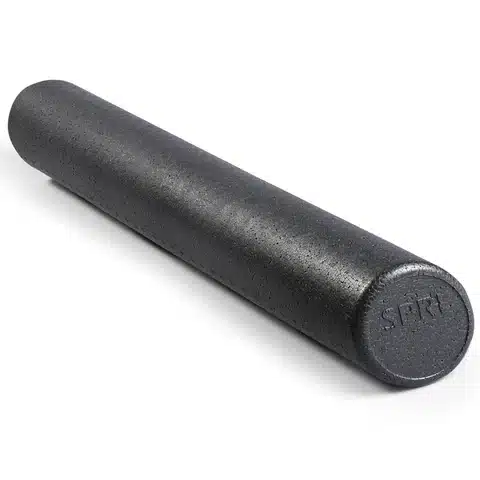
2. High-Density Foam Rollers
If you’re an athlete with extremely tight muscles that require additional attention or experience DOMS (delayed-onset muscle soreness), a high-density foam roller is an excellent choice.
It is denser than a soft roller and more effective at relieving tight muscles and trigger points.
The denser foam material is more durable and long-lasting than traditional foam rollers, which can lose their shape over time.
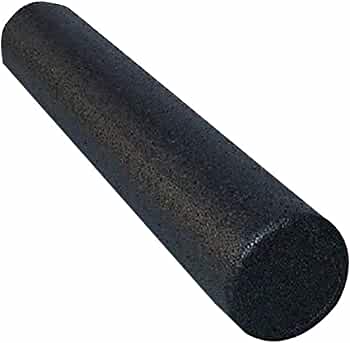
3. Grid Foam Rollers
A grid foam roller is a type of foam roller that has a textured surface with a grid-like pattern.
The textured surface of the grid foam roller provides a deeper massage than a smooth foam roller, which can help break up knots and release muscle tension more effectively.
Only use this style if you’re good at foam rolling and ready for a bit more pain.
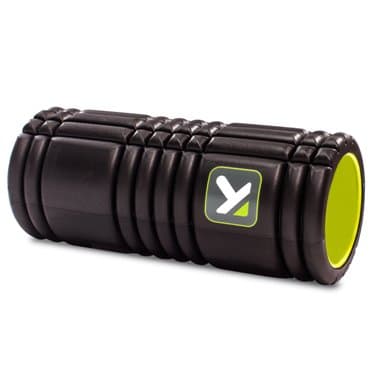
4. Vibrating Foam Rollers
A vibrating foam roller is simply a foam roller that vibrates like a massage gun. Athletes and therapists commonly use it to target the fascia that surrounds the muscles.
These foam rollers have a built-in motor that provides vibration to the muscles.
The vibrating foam roller applies deep and sustained pressure to the muscles, which helps increase blood flow and alleviate tight knots, lumps, and bumps.
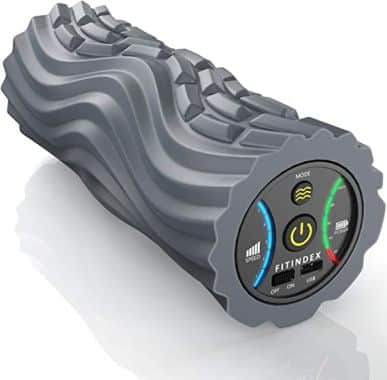
5. Deep Tissue Foam Rollers
This roller is an even more advanced option than a grid roller and should only be used by healthy athletes.
It is extra firm, and the bumps built into the roller offer more focused trigger point relief, reportedly stimulating deeper layers of muscle.
This roller is ideal for use after a particularly intense workout. While it may be quite painful initially, it increases soft tissue flexibility and provides long-lasting pain relief.
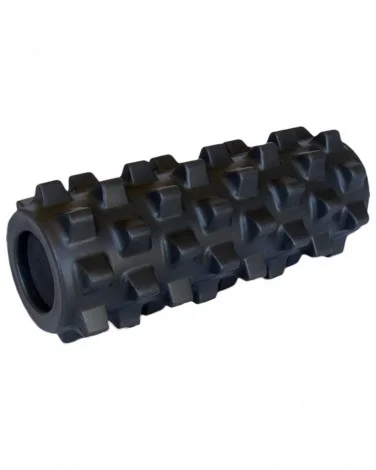
Takeaways
- Foam roller exercises are a great way to start getting rid of aches and pains.
- It can be beneficial for easing sore muscles and reducing inflammation.
- Foam roller exercises help increase joint mobility and range of motion.
- Foam rolling can also be an important tool for cooling down after exercise.
- Foam rolling can also be useful if you regularly sit or stand for your job or have aches and pains.

Manish brings over 10 years of hands-on experience in weight lifting and fat loss to fitness coaching. He specializes in gym-based training and has a lot of knowledge about exercise, lifting technique, biomechanics, and more.
Through “Fit Life Regime,” he generously shares the insights he’s gained over a decade in the field. His goal is to equip others with the knowledge to start their own fitness journey.
